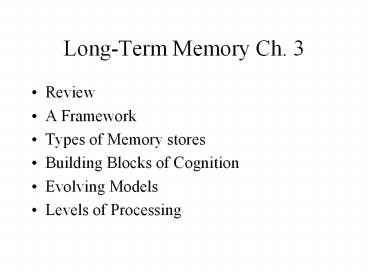Long-Term Memory Ch. 3 - PowerPoint PPT Presentation
1 / 15
Title:
Long-Term Memory Ch. 3
Description:
Long-Term Memory Ch. 3 Review A Framework Types of Memory stores Building Blocks of Cognition Evolving Models Levels of Processing LTM Major themes Learning as a ... – PowerPoint PPT presentation
Number of Views:63
Avg rating:3.0/5.0
Title: Long-Term Memory Ch. 3
1
Long-Term Memory Ch. 3
- Review
- A Framework
- Types of Memory stores
- Building Blocks of Cognition
- Evolving Models
- Levels of Processing
2
LTM Major themes
- Learning as a constructive process
- Mental frameworks organize learning (schemas)
- Extended practice
- Self-awareness and self-regulation
- Motivation and beliefs are critical
- Social interaction is fundamental
- Strategies and competence are contextual
3
Review Sensory Memory and Perception
- Perception is a top down and bottom up process.
- Pattern recognition (oh its a face)
- Sensory Registers
- Visual register Sperlings partial report
proceduresubjects recall fades with time
although all letters were registered. - Auditory register as cue delay increases,
performance decreases. - Sperlings study supports that info. lasts 0.5 in
the icon and over 3 seconds in the echo.
4
Working Memory
- 72 chunks of information
- Forgetting is commonly due to interference or new
information being presented rather than decay
(passage of time) - Accessing information Serial and Parallel
searching (simultaneous is a better word) - Self-terminating or exhaustive
5
- More on Working Memory
- Executive control system
- -Visual-spatial sketch pad (holds visual
information in WM to perform computations) - -Articulatory Loop (holds auditory info.)
- WM is the place where meaning is made!
- What we know has a direct impact on WM
- WM is domain specific not general
- WM is essential for self-regulation
- WM develops over time use and development
6
LTM
- Declarative, Procedural and Conditional Knowledge
- Declarative
- Semantic (general concepts and principles)
- Episodic (personal or autobiographical)
- Which is the largest schema in LTM? What type of
knowledge constitutes it?
7
- What is deja vu?
- Implicit (without awareness)and Explicit
- memory (with awareness)
8
Building Blocks of Cognition
- Concepts (defining attributes, exemplars and non
exemplars) - How would you teach a concept?
- Take 10 minutes and teach a concept to your
group.
9
- Propositions, small units of meaning consisting
of a predicate and argument - Propositions are remembered by meaning
or interpretation not literally - Schemata, framework for understanding and
processing - What is the largest schema? How does it affect
instruction. - Memory is reconstructive
- Schemas bias perception and reconstruction.
10
More LTM possible set ups
- Pavios Dual Encoding Verbal and Imaginal
systems - Network Models Spreading activation, focus
units, hierarchical structure or web - Connectionist Models
- Serial (linear) and Parallel (simultaneous,
multiple path processing) - Pathways are stored not information, it is the
traces of learning rather than the contents. - Context affects intrepretation
- Processing can occur over multiple levels
11
Another Perspective
- Levels of Processing
- Memory as the traces of thinking.
- Emphasis on thinking as a process.
- Deep and Surface Learning
12
Deep and Surface Processing
- Deep Processes
- Meaningful
- Personal or self-referencing
- Autonomous
- Hieraricical
- Integrated
- Proactive
- Surface Processes
- Linear
- Teacher-referenced
- Dependent
- Segemented
- Reactive
13
For Instruction
- Build on prior knowledge
- Help students activate current schemas
- Help students organize in meaningful chunks
- Foster procedural knowledge
- Provide chance for students to use both verbal
and imaginal
14
- Help students focus attention and allocate
resources. - Provide practice for automaticity.
- Provide sufficient data.
- Promote self-regulation.
- Present in visual and auditory modalities.
15
- Demand/deserve attentionchange the environment
- Be novel, that gets attention
- Be predictable, learners like information
congruent with their schemas - Check perception frequently
- Create cognitive dissonance
- Make learning relevant!

